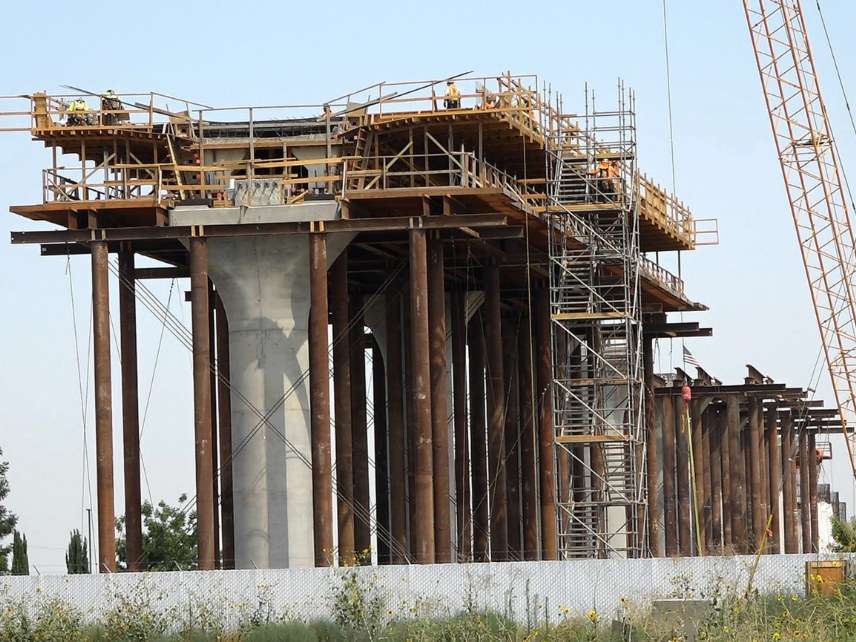California's Boondoggle Bullet Train About to Break the Bank
The money pit is turning into a black hole, as critics predicted.

Will California's high-speed rail plan go bankrupt before the state even finishes building the first leg? Maybe, if we're lucky.
On Tuesday, the officials in charge of the massive $64 billion boondoggle were formally told what everybody with any lick of sense has been saying from the start: They had wildly underestimated the costs and woefully underbudgeted just the first stretch of train construction by billions.
The first 119-mile stretch of the bullet train project in the central part of the state is going to cost $10.7 billion, which is much higher than the original $6 billion budgeted. This is actually the second time the cost for just the first leg of the project has skyrocketed. In September, the cost of the initial leg of the project jumped $1.7 billion.
None of this is a shocker to anybody who has been remotely paying attention to this project. From the very beginning, critics who analyzed the state's bullet train plan warned that the projections were way off. And deliberately so: The ballot initiative authorizing the train's construction requires that it not demand additional operational state subsidies, so there was a pretty significant incentive for the project's proponents to insist that it would be built within specifications. In 2008, a decade ago, Reason Foundation analysis determined that the projections for the costs of both building and operating the train were off by billions.
They were right. So was the Federal Railroad Administration, which predicted a year ago that the cost of this first leg would rise to $10 billion.
And to be clear, right now there does not appear to be much real thought about how this train project can actually progress beyond this initial phase. Ralph Vartabedian of the Los Angeles Times politely understates:
It remains unclear how the Central Valley cost increases will affect the total program, which under the 2016 business plan is supposed to cost $64 billion. But the jump in the Central Valley — a 77% increase above the original estimate — suggests the authority and its consultants have vastly underestimated the difficulties of buying land, obtaining environmental approvals, navigating through complex litigation and much else.
Assuming the rest of the project saw the same budget increase, the whole project would skyrocket to more than $113 billion. And you probably shouldn't assume that the project's unexpected budget increases will scale at the same rate. The train's construction will get more challenging as it heads toward San Francisco and Los Angeles.
Or maybe "if it heads toward San Francisco and Los Angeles" is a better way to talk about the train's future. This boondoggle has been propped all along the way by Gov. Jerry Brown, who is entering into his final stretch as governor this year. He has been insistent in setting aside money to keep the project going even as more Democrats within the state have been increasingly concerned.
But as the Los Angeles Times notes, they may be a little shy about speaking too loudly. Vartabedian says Lt. Gov. Gavin Newsom, running to succeed Brown as governor, has declined for the past two years repeated requests to be interviewed about the high-speed train project's future.
Back in 2014, though, Newsom was more vocal and public when he reversed position. Like many institutional California Democrats, he supported the bullet train at first. But then once he recognized the costs growing out of control, he turned against it. He also said at the time that many Democrats felt the way he did, but few were saying so publicly.
That was before he announced he was running for governor, though. Newsom's acknowledgement tracks with observations by Reason's Matt Welch and former editor Virginia Postrel that the political class in California knew full well this was all a fancy boondoggle designed to appeal those who glamourized zipping across the Golden State landscape in a shiny, superfast train.
Does Newsom still oppose Brown's train project? Or, assuming he becomes California's next governor, will he dip into the $13.5 billion "rainy day" fund and the state's surplus to try to keep the boondoggle going and the pockets of the train project's crony beneficiaries lined?

Show Comments (29)